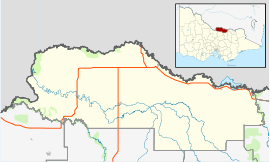Boomahnoomoonah
| Boomahnoomoonah Victoria | |||||||||||||
|---|---|---|---|---|---|---|---|---|---|---|---|---|---|
 Boomahnoomoonah | |||||||||||||
| Coordinates | 36°05′57″S 146°05′05″E / 36.09917°S 146.08472°ECoordinates: 36°05′57″S 146°05′05″E / 36.09917°S 146.08472°E | ||||||||||||
| Postcode(s) | 3728 | ||||||||||||
| LGA(s) | Shire of Moira | ||||||||||||
| State electorate(s) | Ovens Valley | ||||||||||||
| Federal Division(s) | Murray and Indi | ||||||||||||
| |||||||||||||
The town area of Boomahnoomoonah is part of the Shire of Moira local government area. On the Boomahnoomoonah Road, approximately 12 km southeast of Yarrawonga it was once a small town having its own school, church, and post office. Comprising medium to large farms the area is predominantly agricultural, focusing on dairying as well as sheep and cattle grazing, some viticulture is also practised. Boomahnoomoonah is the longest single-word place name in Victoria.
Early history
The Victorian Aborigines are the traditional owners of the land; in particular the Bangerang people, a family group of the Yorta Yorta people who occupied a large area along the Murray river. A former postmistress claimed that the towns name was, "...aboriginal for 'big water'..."[1] but other local areas also share similar meanings for their names.
The early exploration of the area was conducted by Hamilton Hume and William Hovell during the first half of the 19th century. Squatters soon moved into the area and vast stations for grazing sheep and cattle were quickly established. During the 1860s the Victorian Land Acts allowed for the subdivision of large holdings and a provision for Selectors to take up small allotments at minimal cost. This saw an increase in the population of the area. The names of some early Selectors include Edward Lewis who took up 272 acres, Daniel Doherty who occupied 191 acres and the Woods family who selected over 500 acres.
In March 1881 a post office was opened to service local residents but closed in February 1939.[2] Around the same time the Boomahnoomoonah State School accepted its first students and operated at various times up until the 1950s when it closed permanently.[3] St Oswald's Church of England began services in May 1890 and continued to serve the community until its closure due to poor numbers (a congregation of 6-7), and the dilapidated state of the church itself, in 2012.[4]
Later history
During the early 1900s the provision of irrigation was improved which in turn encouraged the growth of local dairy farms. At this time he town had its own cricket club and was relatively competitive in the local district.
The area continued to grow up until the mid 1960s when advances in agricultural methods reduced the need for manual workers and the area gradually reverted to larger holdings. Lack of employment opportunities and an aging local population saw many, if not all, local amenities removed in deference to the larger district towns.[5]
References
- Notes
- ↑ Boomahnoomoonah And Upotipotpon Stay Unchanged. (1936, May 25). Barrier Miner (Broken Hill, NSW : 1888 - 1954), p. 4. Retrieved November 6, 2014, from http://nla.gov.au/nla.news-article47899450
- ↑ Premier Postal History, Post Office List, retrieved 2008-04-11
- ↑ Opinion. Border Mail. February 26, 2009.
- ↑ The Advocate. (Newspaper of the Anglican Diocese of Wangaratta). Issue 6, May 2012.
- ↑ Small towns and settlements of the Moira Shire: Draft context report. CPG Australia, Shepparton, 2012
- Bibliography
- Charnstrom, Joyce & Symes, Jacye (1993). Wilby walkabout 1873-1933. Benalla Secondary College, [Benalla, Vic]
- St Oswald's Church of England (Boomahnoomoonah, Vic.) - 1890-1990: A centenary souvenir. St Oswald's Church [Yarrawonga] (1990)